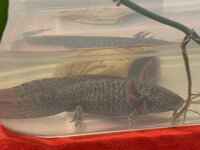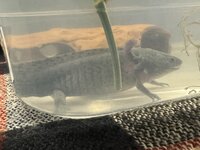appshan
New member
Hi, everyone!
I have 2 axolotls: one is a wild-type (8 inches) and the other is a melanoid (7 inches). I bought them 5 months ago, so I am unsure if they are now adults/sexually mature. Could you please tell me if they are male/female?
Also, they are currently in separate bare-bottom tanks, but I would like to house them together soon. The family I got them from keeps 3 adults in a 20-gallon long tank. Should I put mine in a 20-gallon as well? And how much sand would I need at the bottom?
Thank you so much!
I have 2 axolotls: one is a wild-type (8 inches) and the other is a melanoid (7 inches). I bought them 5 months ago, so I am unsure if they are now adults/sexually mature. Could you please tell me if they are male/female?
Also, they are currently in separate bare-bottom tanks, but I would like to house them together soon. The family I got them from keeps 3 adults in a 20-gallon long tank. Should I put mine in a 20-gallon as well? And how much sand would I need at the bottom?
Thank you so much!



